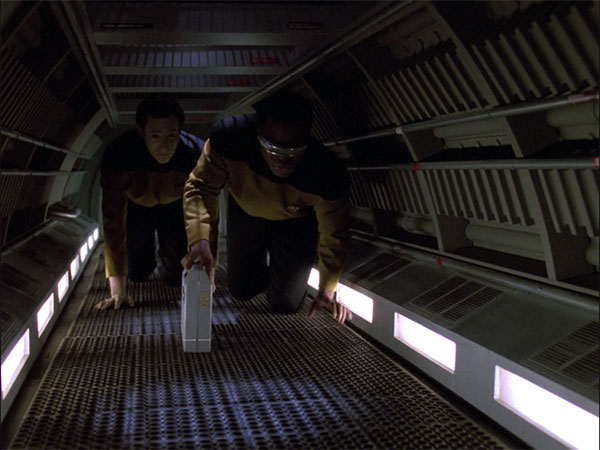Now that you're familiar with programming fundamentals, we'd like to introduce you to what you'll really be spending most of your time doing: debugging.
If debugging is the process of removing software bugs, then programming must be the process of putting them in. - Edsger W. Dijkstra
Today you are Geordi La Forge, chief engineer of the Enterprise from Star Trek. Just like Geordi would climb through the narrow corridors of the Jefferies tubes to troubleshoot the Enterprise's issues, you'll be using debugging techniques to get in between the nooks and crannies of your programs to figure out what's really going on.
Geordi and Data Crawling Through a Jefferies Tube
You should be comfortable with:
- ruby fundamentals
- working on your command line
- working with your editor
By the end of this exercise, you should have a good understanding of how to debug programs by intercepting them as they run to see what's going on.
You'll need your editor for coding, a terminal for running and testing code, and a browser for looking up documentation.
In addition, you'll need to download this repo and ensure pry is installed.
# Clone Repo
git clone [email protected]:bitmakerlabs/geordis-replicator.git
# Go into project folder
cd geordis-replicator
# Install pry
gem install pryLet's run the app once. Use the replicator to make Geordi a coffee and get the day started:
$ ruby geordis-replicator.rb 1Notice the 1 in the command above. It's an argument you're passing into the geordis-replicator ruby program. That number 1 represents the episode number you'd like to play.
The program should run properly. In this case the replicator should make a coffee for Geordi, and then prompt you to move on to the next episode. Before you start the next episode, take a look at the files in the /episode-01/ subfolder. In here you'll find the Enterprise class, Replicator class, and all the other classes to make the replicator work. Episode 1 doesn't have any bugs, so you don't need to fix the program.
Now take a look at the files in the /base/ folder. This is the "framework" of this assignment. You should not change any of these files to fix the bugs in each assignment, or else future episodes may not work properly. You'll may also notice a very long named folder beginning with .DO-NOT-LOOK-blah-blah.... This folder is used to generate each exercise, and you may spoil the exercises for yourself if you look at the files in this folder.
Let's first run the second episode and see what happens:
$ ruby geordis-replicator.rb 2As you can see, one of our characters is not happy when the replicator doesn't function properly.
Take a look at reactor.rb and notice the following line:
# turn_onThe code to turn on the reactor has been commented out. Uncomment that and run the program again. Our character should be happy with their drink now!
Sometimes it pays to stay in bed on Monday, rather than spending the rest of the week debugging Monday's code. - Christopher Thompson
Let's first run this episode and see what happens:
$ ruby geordis-replicator.rb 3To troubleshoot it, we'll need to follow the flow of the program. Let's start with geordis_replicator.rb, the program you run from the command line:
require_relative 'base/app'
App.newThis simply loads base/app.rb into memory and then creates a new instance of App.
Let's see what happens when a new instance of App is created:
# base/app.rb
def initialize
command = ARGV.first
Display.help_and_exit unless command
if command.slice(0, 2) == '--'
Generator.invoke(command)
else
episode_number = pad_with_zero(command)
play(episode_number)
end
endThis initialize method:
- Ensures an episode # was passed in as an argument.
- Invokes the
playmethod.
Along with displaying the episode text, the play method:
- Creates an instance of the
Episodeclass. - Loads the ruby exercise files (i.e. the files in the
episode-03/folder).
- Creates a new instance of Enterprise.
- Tries to replicate a drink.
Let's move on to the episode-03/enterprise.rb file. The episode-03/ folder is where your debugging should begin, and you can change any of the .rb in this folder to make the replicator work properly. (Note that you shouldn't change the episode.json file in this folder).
Inside episode-3/enterprise.rb, the Enterprise is constructed:
def initialize
@reactor = Reactor.new(self)
@transporter = Transporter.new(self)
@cupboard = Cupboard.new
@pantry = Pantry.new
@replicator = Replicator.new(self)
endYou can then continue to follow the flow by looking at the initialize methods of each of the Enterprise components.
After the Enterprise is created, execution returns toApp#play, where you'll find the line:
@enterprise.replicator.replicate(@episode.recipe)This is where the magic happens! (or is supposed to happen, if only our replicator was working properly).
Take a look at Replicator#replicate:
def replicate(recipe)
@recipe = recipe
retrieve_glass
transport_ingredients_to_glass
mix
adjust_temperature
transport_glass_to_replicator_plate
end- A recipe is passed in as a local variable (
recipe), and then assigned to an instance variable (@recipe).
- The replicator transports a glass from the cupboard to the replicator's tummy.
- The replicator transports ingredients into the glass.
- The replicator mixes the contents of the glass.
- The replicator transports the glass into the reactor core, adjusts the temperature, and then transports it back to the replicator's tummy.
- The replicator then transports the glass from inside its tummy on the replicator's serving plate so the character can obtain it.
Let's run the program and see what happens:
$ ruby geordis-replicator 3Hmmm.. it seems like there's a problem with the temperature.
Add require 'pry' to the top of episode-3/replicator.rb, and inside of Replicator#adjust_temperature, add binding.pry:
def adjust_temperature
return unless glass_in_tummy
binding.pry # <--- add binding.pry here
glass_in_reactor_core = @enterprise.transporter.energize(obj: glass_in_tummy, from: @tummy, to: @enterprise.reactor.core)Run the program again and it should bring you to the pry prompt:
[1] pry(#<Replicator>)>Type glass_in_tummy at the prompt to see what the glass currently looks like.
[1] pry(#<Replicator>)> glass_in_tummy
=> #<Glass:0x007f841c35e8f8
@errors=[],
@inside=
#<Location:0x007f841c35e8d0
@contents=
[#<Ingredient:0x007f841c33c168 @name="chocolate">,
#<Ingredient:0x007f841c33c258 @name="sugar">,
#<Ingredient:0x007f841c33c0c8 @name="milk">]>,
@temperature=37>Notice the temperature is 37 Celsius.
Let's move our binding.pry statement to after the temperature adjustment has been finished:
def adjust_temperature
<--- snip --->
@enterprise.transporter.energize(obj: glass_in_reactor_core, from: @enterprise.reactor.core, to: @tummy)
binding.pry # <--- move binding.pry to here
endRun the program again and check the temperature:
[1] pry(#<Replicator>)> glass_in_tummy
=> #<Glass:0x007fa7bea35b70
@errors=[],
@inside=
#<Location:0x007fa7bea35b48
@contents=
[#<Ingredient:0x007fa7bea0fc40 @name="sugar">,
#<Ingredient:0x007fa7bea0fbc8 @name="chocolate">,
#<Ingredient:0x007fa7bea0fb50 @name="milk">]>,
@temperature=1>Notice the temperature went down to 1 degree! No wonder our character is upset. Somewhere in this method, or a method this method calls, is causing our problem.
Let's move our breakpoint to inside the loop:
while glass_in_reactor_core.temperature != desired_temperature &&
number_of_adjustments < maximum_adjustments_allowed
binding.pry # <--- move binding.pry to here
if glass_in_reactor_core.temperature > desired_temperature
@enterprise.reactor.cool_items_in_core
elsif glass_in_reactor_core.temperature < desired_temperature
@enterprise.reactor.heat_items_in_core
end
number_of_adjustments += 1
endRun the program, and check what temperature of our glass is. Note that the glass has been moved to the Reactor Core and is now being tracked in the local variable glass_in_reactor_core:
[1] pry(#<Replicator>)> glass_in_reactor_core
=> #<Glass:0x007fb08e23d660
@errors=[],
@inside=
#<Location:0x007fb08e23d610
@contents=
[#<Ingredient:0x007fb08e216a38 @name="sugar">,
#<Ingredient:0x007fb08e2169c0 @name="chocolate">,
#<Ingredient:0x007fb08e216948 @name="milk">]>,
@temperature=37>The temperature is currently 37 degrees -- the starting temperature of all our drinks. Let's let the loop cycle once by pressing CONTROL-D to exit pry. It will run the code below binding.pry, and then cycle back to the breakpoint. Type glass_in_reactor_core again to see the temperature:
[1] pry(#<Replicator>)> glass_in_reactor_core
=> #<Glass:0x007fb08e23d660
@errors=[],
@inside=
#<Location:0x007fb08e23d610
@contents=
[#<Ingredient:0x007fb08e216a38 @name="sugar">,
#<Ingredient:0x007fb08e2169c0 @name="chocolate">,
#<Ingredient:0x007fb08e216948 @name="milk">]>,
@temperature=1>Ah ha! Somewhere in the loop the temperature has gone down to one degree. Let's run the loop one more type by pressing CONTROL-D. It should bring us back to the pry prompt again. Let's see if our temperature changed:
[1] pry(#<Replicator>)> glass_in_reactor_core
=> #<Glass:0x007fb08e23d660
@errors=[],
@inside=
#<Location:0x007fb08e23d610
@contents=
[#<Ingredient:0x007fb08e216a38 @name="sugar">,
#<Ingredient:0x007fb08e2169c0 @name="chocolate">,
#<Ingredient:0x007fb08e216948 @name="milk">]>,
@temperature=1>Nope.. still one degree. Unfortunately our loop is going to happen 48 more times. Fortunately, we can break out of our program it with !!!:
[1] pry(#<Replicator>)> !!!You should be back at your terminal prompt after you typed !!!.
I have a feeling the issue is in the Reactor. Open up episode-3/reactor.rb. Near the bottom are our methods for heating and cooling:
def heat_items_in_core
@core.contents.each do |item|
item.temperature = 1 if draw_power
end
end
def cool_items_in_core
@core.contents.each do |item|
item.temperature -= 1 if draw_power(2)
end
endheat_items_in_core sets the temperature to 1 degree, but the cooling method subtracts one degree from the current temperature. I think our heating method should just increment the temperature by one degree instead of setting it to one degree. Let's fix that now:
def heat_items_in_core
@core.contents.each do |item|
item.temperature += 1 if draw_power. # FIXED!
end
endRun our program...
...and our character is happy! Good job Geordi!
Debuggers don't remove bugs. They only show them in slow motion. - Unknown
Every time you run the program, each episode will have one of the following outcomes:
- character's drink creation is successful
- drink does not appear
- drink is the wrong temperature
- drink has the wrong ingredients
- syntax error
You can look at the episode.json file in each episode folder to see what temperature each beverage should be as well as what ingredients it should contain (note: you shouldn't modify this file).
Feel free to change any .rb files inside of each /episode-XX/ folder in order to fix the problem. Some exercises have multiple bugs. How you fix issues is up to you: for example, you could adjust a program's logic and / or increase the amount times components are stocked. As long as our characters get the drink they want with the right ingredients and at the right temperature, then any fix is valid.
And now, fix the issues the remaining episodes. Engage!
Debugging is anticipated with distaste, performed with reluctance, and bragged about forever. - Dan Kaminsky
Remember to submit your code when you're finished.
It's not a bug – it's an undocumented feature. - Unknown
- Copy the folder
episode-01toepisode-16.
- Modify the episode's parameters in
episode-16/episode.jsonto reflect a new character, beverage and add some funny lines for this character. - Introduce some bugs in various components of the Enterprise (i.e.
.rbinepisode-16/) - Test to ensure the program runs (but branches to the character not being happy)
- Send over the
episode-16folder to your classmates. Have them place your folder in their folder, and then try to solve your exercise.
Currently our replicator only handles beverages. Expand the replicator's capabilities to handle solid foods, and then treat yourself to Worf's favourite dish: Rokeg blood pie. You deserve it!
Rokeg Blood Pie... mmmmm...yum.
Without requirements or design, programming is the art of adding bugs to an empty text file. - Louis Srygley


